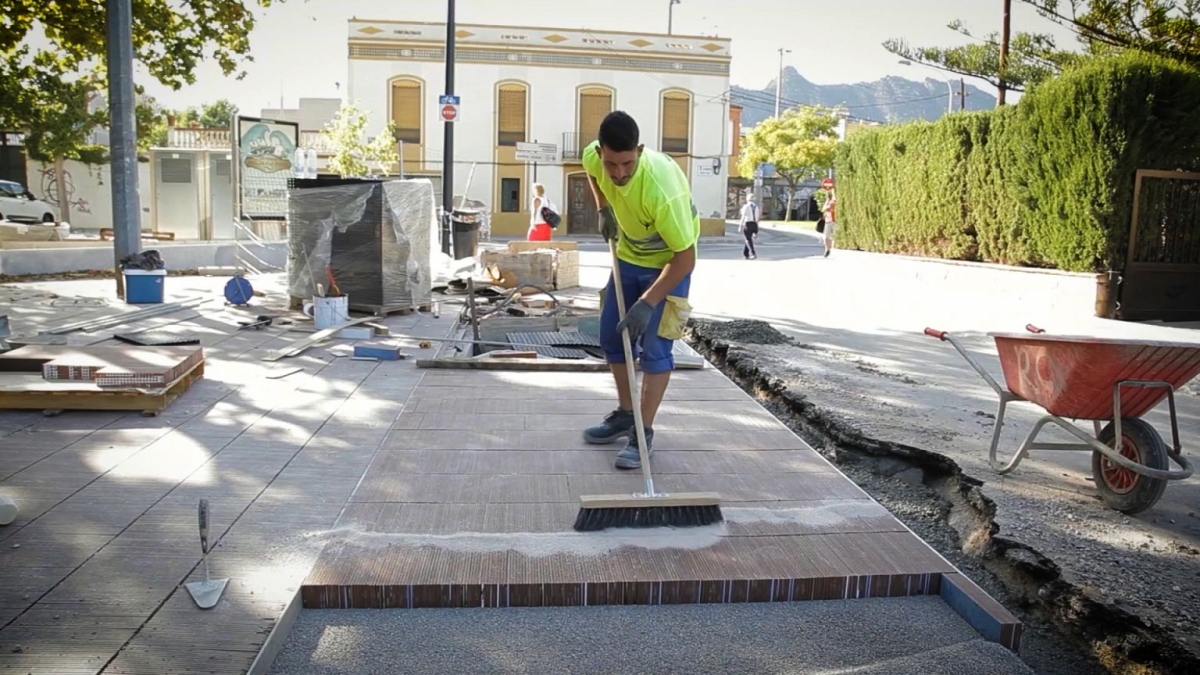Copyright Euronews Copyright Euronews
In this episode of Smart Regions, we look at how new ceramic paving, developed in Spain’s Valencia region, aims to curb flooding risks during heavy rain in urban areas.
When floods hit the Valencia region last October, following torrential rainfall, they were devastating and deadly. A reminder, it’s said, of how dangerous climate change has become.
Spain, like other countries, is having to adapt to more extreme weather. And, in the Valencia region, EU-funded innovation has spawned a new solution, right under people’s feet.

Permeable, ceramic paving tilesEuronews
The concept of footpath paving has been redesigned using ceramic tiles, placed and spaced on their sides, to maximise absorption of water into the ground.
Experts say it wouldn’t prevent the type of disaster seen last year, with the overflow of a river system, but would improve drainage capacity and reduce flooding risks when heavy rain hits urban areas.

Water infiltration test, CastellónEuronews
“This permeability is achieved through interstices that remain between plate and plate, vertically,” explains Ignacio Andrés Doménech, Director, School of Civil Engineering, Polytechnic University of Valencia.
“In this case, these paving stones, supported by layers of gravel, will allow the percolation of water, its filtration through a porous structure, that will also provide benefits in terms of improving the quality of these waters.”
The footpath design was originally developed as part of an EU-funded project, coordinated by the Institute of Ceramic Technologies in Castellón. It saw demonstration paving installed in the municipality of Benicàssim.

Institute of Ceramic Technology, CastellónEuronews
More recently, a second initiative called Drainker, also EU-supported and managed by the Institute, has focused on refining and industrialising the concept, with a new experimental site in Castellón.
Tests, carried out as part of its work, have shown that water can be absorbed at a rate of 10,000 litres per square metre, per hour.
“This project was really born for several reasons,” explains Yolanda Reig, Director General, Institute of Ceramic Technology.
“It was born out of the need to collect rain and the need to stop excess heat in cities.”
Yolanda Reig Director General, Institute of Ceramic Technology

Yolanda Reig, Director General, Institute of Ceramic TechnologyEuronews
“One was because of an excess in the stock of ceramic materials with low commercial value. It was born out of the need to collect rain and the need to stop excess heat in cities. We have managed to combine the three ideas to get to a product like Drainker.”
Jorge Corrales, an architect at the Institute, added: “There’s a Spanish company that’s been very interested and has decided to start industrialising and commercialising this product, which is currently available for use in both national and European projects.

Jorge Corrales, Architect, Institute of Ceramic TechnologyEuronews
“And, in the last few months, we’ve had meetings with different architectural studios and city councils, with the objective for incorporating this project into real projects in urban spaces.”
The total budget for the Drainker project is just over €142,000. Around 60% of the funding has been provided by the European Regional Development Fund, with the remainder coming from the Valencian Government.
“On one hand, it opens-up a new line of business for the ceramic industry, which is a key part of Castellón’s identity. On the other, it offers an innovative solution to help mitigate a serious challenge in our region: the impact of torrential rains,” said Juan José Cortés, General Director of Innovation at the Valencian Government.
“Unlike traditional surfaces such as asphalt or concrete, this system significantly improves drainage capacity.”
Juan José Cortés General Director of Innovation, Valencian Government
“Unlike traditional surfaces such as asphalt or concrete, this system significantly improves drainage capacity, thereby reducing the risk of flooding.”
He continued: “Our geographic location on the western Mediterranean makes us especially vulnerable to the effects of global warming. Experts predict that both droughts and torrential rainfall will become more frequent and intense, so we must prepare to meet this complex scenario head-on.
“We will actively promote the installation of these tiles in public spaces, following expert recommendations. Furthermore, we are open to collaborating with other regions and institutions interested in replicating this kind of sustainable solution.”



